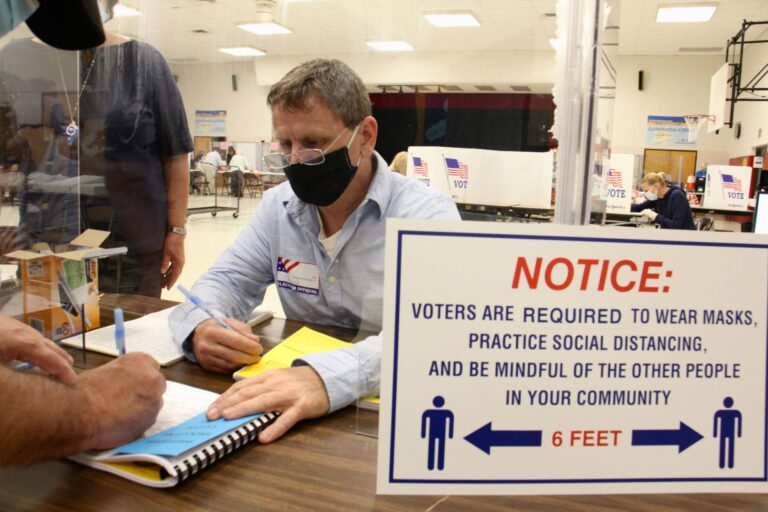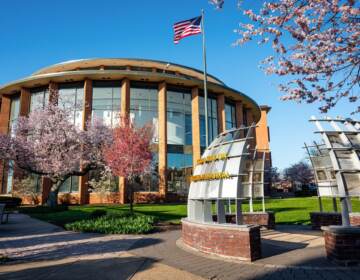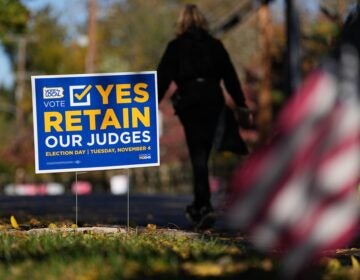Pennsylvania’s legislative redistricting is done. But its local impacts are still unfolding
Legislative redistricting has reshaped Pennsylvania's House of representatives. Here's how two communities are grappling with the changes.
Listen 6:03
Poll worker Chuck Kellander interacts with voters through a plexiglass screen at Belmont Hill Elementary School in Bensalem, Bucks County. (Emma Lee/WHYY)
As soon as Pennsylvania’s new state House map became public, Eric Epstein decided to run for the seat in his Harrisburg suburb.
This isn’t his first time. Over the years Epstein, a reform-minded Democrat who, by his own telling, has “pissed everybody off,” has been a perennial candidate for various offices — state House, Senate, county controller — and has generally lost long-shot races in traditionally GOP-held districts.
But this is the first year in recent memory that he or any Democrat is likely to win the 105th state House District.
Under the new map, Epstein said, the Harrisburg region now has districts “where regardless of your party, you have the opportunity to prevail. And that’s the marketplace of democracy. That’s what’s been missing.”
Epstein’s region isn’t the only one seeing big changes. The latest round of legislative redistricting hit Pennsylvania’s Republican-controlled House of Representatives like an earthquake, and stands to make Democrats more electorally competitive than they have been in at least two decades.
The map also makes districts, on average, less likely to swing between parties.
The effects of those changes are straightforward on a statewide level: Democrats will probably pick up more House seats — though likely not enough to wrest control of the chamber from Republicans this year — and will have relatively more power in the legislature for the next decade.
But zoom down to individual counties and municipalities, and the conversation about what exactly this map will do grows much more complicated.
To highlight the ways these maps can affect towns, elected officials, and voters on the local level, WHYY took a closer look at two small parts of the map: Harrisburg and its blue-shifting suburbs, and moderate Bucks County.
Harrisburg
Like many of Pennsylvania’s smallish cities, Harrisburg is solidly blue, with suburbs that have also gotten more liberal over the last decade.
That political shift never translated to more seats for Democrats, though. Since 2012, the area has been drawn with Harrisburg as a single, very blue district, with its liberal suburbs wrapped into bigger districts that stretch into more conservative communities farther from the city. Those suburban districts look moderate and ripe for party flips on paper, but all of them have been steadily held by Republicans since at least the 1960s.
The new state House map upends that dynamic. Now, Harrisburg is divided into two seats, both of which include some of the nearby suburbs. A third compact seat anchored in relatively populous, liberal suburban precincts will also be safe for Democrats. That’s the one where Epstein is running.
He has a primary opponent in Susquehanna Township Commissioner Justin Fleming, and other Democrats may still jump in the race. But he said no matter who wins the primary, “it’s likely that you’re going to go from one D to three Ds” in the area. “You’re going to have this remarkable confluence of events where there’s actually a Democratic caucus [from Harrisburg] in the House of Representatives.”
Kimeka Campbell, a Harrisburg activist with a Ph.D. in education and a local talk show, Black Newsbeat, sees potential in the new map. But she has concerns, too. Namely, that Harrisburg will have to share its newly split representation with the suburbs.
“We’re dealing with, in a lot of cases, abject poverty at much higher levels than our neighbors,” she said. “I think a lot of people are worried that those issues are going to get lost in the sauce.”
Campbell is a Democrat. She spent time working on both of Barack Obama’s campaigns. But politically, she considers herself fairly independent. The thing that’s most important for her, she said, is competent local representation. For instance, she thinks Rep. Sue Helm (R-Dauphin) did a great job with her sprawling district, which stretched from conservative Lebanon County to Harrisburg’s liberal suburbs. Helm’s constituents, she said, “really feel like they can go to her when there’s a problem”
Helm, who has held the 104th District since 2007, is now drawn into the newly liberal 105th District with her colleague Andrew Lewis (R-Dauphin). She hasn’t officially announced her re-election plans, but asked about her odds in the new district, said, “I wouldn’t even waste my money…I’d rather give my money to the homeless”
“The only good thing I have to say about the district is it’s very compact,” she added. “It’s 29 square miles. I would have loved to have had a district like that for the last 16 years.”
Ultimately, Campbell finds new districts to be reasonable — in her mind, the big question is what kind of person they’ll elect. Others, she said, seem to be thinking similarly.
“Folks are split,” she said. “Folks are like, this could be really a good thing for us or this could be a really bad thing for us. I lean towards — I’m still not sure. It depends on who we get.”
Bucks
More than a hundred miles away in his southern Bucks County office, surrounded by printouts of various district lines, State Rep. Frank Farry (R-Bucks) has different map-related concerns on his mind.
Under the old map, five of the seats in Bucks were pretty competitive. Three leaned toward Democrats, and two leaned toward Republicans. Right now, Republicans hold seven of the ten.
Under the new map, two of those tossups are significantly less competitive. The 178th got more Republican and the 29th got more Democratic — enough that the incumbent, Meghan Schroeder (R-Bucks) isn’t running again.
Farry’s 142nd District didn’t change much, politically. But he does worry that across the county, these changes to Bucks could lead to a more stagnant delegation. More than most counties, he noted, Bucks districts tend to flip between parties.
“Look, there’s bums on both sides of the aisle and there’s good people on both sides of the aisle,” he said. “But the public should have the opportunity, even if they’re of the same party, to say, ‘that person’s a bum,’ and have the opportunity to change it.”
Legislative maps are drawn by commission in Pennsylvania — leaders from both parties in the House and Senate, plus one court-appointed, nonpartisan tiebreaker. That commission receives a lot of public feedback, and Farry organized hundreds of submissions from Bucks residents.
One of them was Southampton resident Kenneth Stracuzzi. He’s part of a loose coalition of Christian groups that got involved with the mapmaking process, and submitted lots of comments to the mapmakers urging them to keep moderate Bucks as competitive as possible.
The final map moved him out of Farry’s district, and into one that is significantly more conservative.
“Although I’m conservative, I find that disappointing,” Stracuzzi said. “Like, I think that we should work for the best policies, and those policies should rise to the top. And I think that even though this might wind up being a red town and I would be comfortable with most of those decisions, I feel like we lose when we take the competitive edge out of it.”
Carol Kuniholm, who heads the redistricting reform group Fair Districts PA, spent a lot of time in Bucks in the lead-up to the new maps, talking to voters.
She says she understands why voters in a moderate place appreciated competitive districts. But, she maintains, those old lines actually distorted the county.
Bucks, she said, probably shouldn’t have seven GOP seats. The county is historically conservative, but has been steadily getting bluer, despite longtime GOP incumbents continuing to hold seats. Today, it has more than 202,000 registered Democrats and fewer than 193,000 registered Republicans.
“The only way [for Republicans] to get those seven out of ten House seats is to draw quite a few very competitive districts, and to spread out the Democratic and the Republican voters in a way that gives a slight advantage to Republicans in a place where they don’t have that numeric advantage,” she said.
In other words, she added, you can’t undo gerrymandering in places like Bucks without losing some competitive seats.
Does this process work?
Republicans broadly disagree. House Majority Leader Kerry Benninghoff (R-Centre) sued to get the map redrawn, saying among other things that the redistricting panel’s nonpartisan tiebreaker, University of Pittsburgh Chancellor Mark Nordenberg, was too committed to creating districts designed to be responsive to minority voters’ preferences.
The plan “gerrymanders districts in urban areas throughout the Commonwealth to pinwheel and pie-up these municipalities to more ‘efficiently’ spread Democratic voters out to maximize the number of Democratic-leaning seats,” he wrote.
That’s a similar argument to the one Democrats made about the House map ten years ago. In that case, a court ordered the panel to redraw it, though the redraw still favored Republicans. In this new case, the Democratic-controlled Supreme Court was unmoved, and declined to intervene.
Kuniholm thinks this all illustrates the problem with the legislative redistricting process as it stands. It’s political, and whether or not it’s truly unfair, there will always be people who feel cheated.
Her group has long advocated for a citizens’ commission to draw the map, using a process that involves more robust public feedback. So far, that’s been a no-go in the GOP-controlled legislature.
“Maybe once they realize that they will not have the upper hand every time, as they didn’t have this time, maybe there will be an appetite for changing,” Kuniholm said of the mapping process. “But I think it’s probably still too early to know.”

Get daily updates from WHYY News!
WHYY is your source for fact-based, in-depth journalism and information. As a nonprofit organization, we rely on financial support from readers like you. Please give today.







